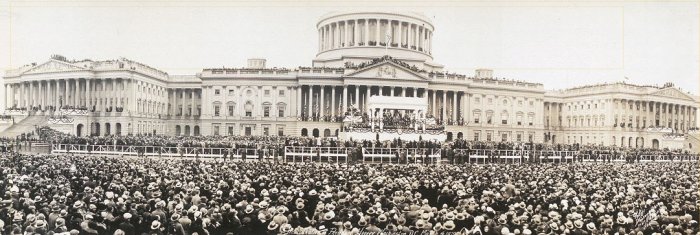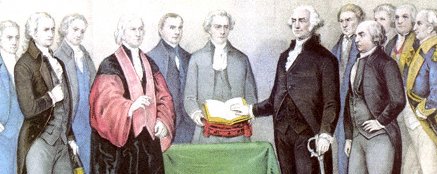
The inaugeration of President Herbert Hoover in 1929
|
Note
In order to ensure a smooth transition of power, there is a need for a
period of time between the election and and the swearing in of the new
period. New presidents have to choose cabinet members and other
key administration members, as well as get up to speed on security
issues and simply began the task of physically moving a new team to
Washington. For the old president, this time in office is
referred to as "the lame duck" period, a term taken from Wall Street
that used to refer to people who could not pay off their
loans--persons, like the lame duck president, without much capital.Before the enactement of the 20th Amendment in 1933, the new president was not sworn until the March following the election. This long delay caused problems. In the "secession winter" after the election of Abraham Lincoln, President James Buchanan watched as secessionists seized federal forts and arsenals. By March 1861, when Lincoln finally took office, the Civil War was nearly lost before it even began. Seven decades later, in the middle of the Great Depression, the lame duck period of president Herbert Hoover seemed far too long. Hoover and Franklin Roosevelt barely communicated and the country waited for decisive action from its newly chosen leader. In response, the 20th Amendment was proposed and adopted. The 20th Amendment moves the date of inauguration from March to "noon on the 20th day of January." Under the Constitution, the old president continues to hold full power through 11:59:59, and then power shifts at noon. Article II, Section 1 requires that the new president, before executing any duties, take a prescribed oath or affirmation. To avoid a constitutional power vacuum, the Inauguration Day program is certain to schedule the swearing in for as close as possible to noon. The Chief Justice of the United States typically administers the oath, although the Constitution does not require that the oath be performed by the Chief Justice. The oath specified in Article II does not include four words recited in all recent inaugurations: "So help me God." The first known use of the phrase "So help me God" in a presidential inauguration was by Chester Arthur, on September 22, 1881, following the death in office of President James Garfield. In 2008, atheist activist Michael Newdow unsuccessfully sued in federal court to block the use of the phrase "So help me God" in Barack Obama's inauguration. On three occasions, presidents (Arthur, Coolidge, and Obama) have re-taken oaths after questions were raised about first attempts. The most recent do-over occurred in 2009 after Chief Justice Roberts got the oath's words out of order in the public inauguration ceremony. |
AMENDMENT XXNote: Article I, section 4, of the Constitution was modified by section 2 of this amendment. In addition, a portion of the 12th amendment was superseded by section 3. Section 1. Section 2.
Article. II.
Before he enter on the Execution of his Office, he shall
take
the following Oath or Affirmation:--"I do solemnly swear (or affirm)
that
I will faithfully execute the Office of President of the United States,
and will to the best of my Ability, preserve, protect and defend the
Constitution
of the United States." |
